PONTIAC GRAND-AM 1995 Owner's Guide
Manufacturer: PONTIAC, Model Year: 1995, Model line: GRAND-AM, Model: PONTIAC GRAND-AM 1995Pages: 354, PDF Size: 17.81 MB
Page 31 of 354

The best way to protect the fetus is to protect the
mother. When a safety belt is worn properly, it’s more
likely that the fetus won’t be hurt in a crash. For
pregnant women, as for anyone, the key to making
safety belts effective is wearing them properly.
Right Front Passenger Position
Was your Pontiac first sold, when new, in Canada? (If it
was, a sticker on the driver’s door will say “conforms to
all applicable Canada motor vehicle
. . . ” etc.) If so,
then this ‘‘Right Front Passenger Position” part doesn’t
apply to your vehicle. To learn how to
use your right
front passenger position safety belts, read the
Canadian
Owner’s Manual Safety Belt Supplement. It comes with
every new Pontiac fist sold in Canada.
The right front passenger’s safety belt works the same
way as the driver’s safety belt. See “Driver Position,”
earlier in this section.
0 Adjust the seat (to see how, see “Seats” in the Index)
so you can sit up straight. Move your seat far enough
forward that your feet touch the
part of the car that is
called the “toeboard” (A). That way you’d be less
likely to slide under the lap belt in a crash.
1-24
ProCarManuals.com
Page 32 of 354
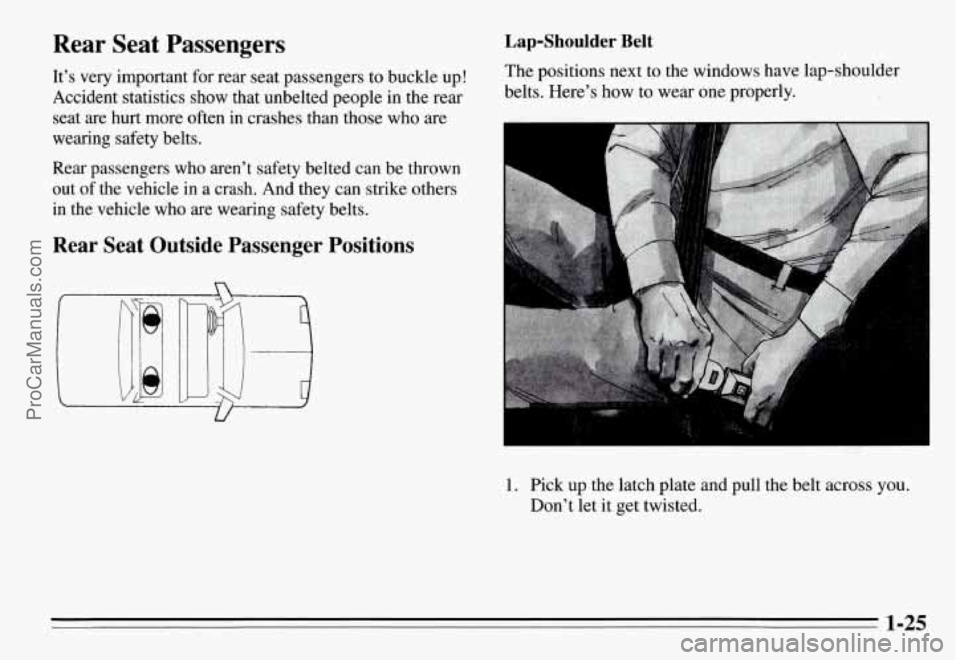
Rear Seat Passengers
It’s very important for rear seat passengers to buckle up!
Accident statistics show that unbelted people in the rear seat are hurt more often in crashes than those who
are
wearing safety belts.
Rear passengers who aren’t safety belted can be thrown
out of the vehicle in a crash. And they can strike others
in the vehicle who are wearing safety belts.
Rear Seat Outside Passenger Positions
Lap-Shoulder Belt
The positions next to the windows have lap-shoulder
belts. Here’s
how to wear one properly.
1. Pick up the latch plate and pull the belt across you.
Don’t let it get twisted.
1-25
ProCarManuals.com
Page 33 of 354

2. Push the latch plate into the buckle until it clicks. would be able to unbuckle the safety belt quickly if
you ever had to.
If the belt stops before it reaches the buckle, tilt the
latch plate and keep pulling until you can buckle it.
Pull up on the latch plate to make sure it is secure.
If the belt is not long enough, see “Safety Belt
Extender” at the end of this section. Make sure the
release button on the buckle
is positioned so you
3. To make the lap part tight, pull down on the buckle
end of the belt as you pull up on the shoulder part.
ProCarManuals.com
Page 34 of 354
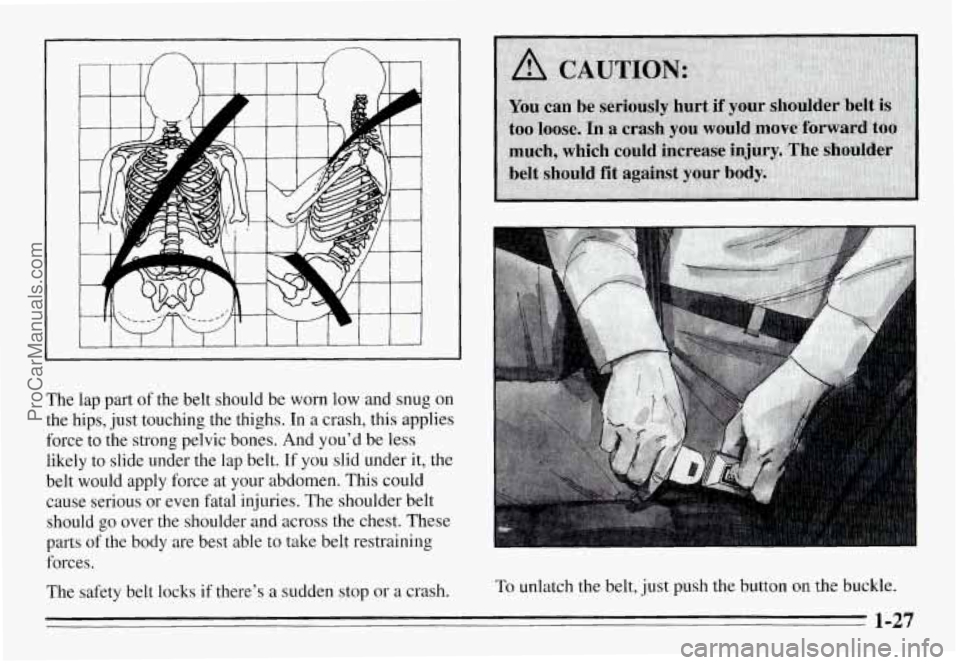
The lap part of the belt should b'e worn low and snug on
the hips, just touching the thighs. In a crash, this applies
force to the strong pelvic bones. And you'd be less
likely to slide under the lap belt. If you slid under it, the
belt would apply force at your abdomen. This could
cause serious or even fatal injuries. The shoulder belt
should
go over the shoulder and across the chest. These
parts of the body are best able
to take belt restraining
forces.
The safety belt locks if there's a sudden stop or a crash. To unlatch the belt, just push the button on the buckle.
1-27
ProCarManuals.com
Page 35 of 354
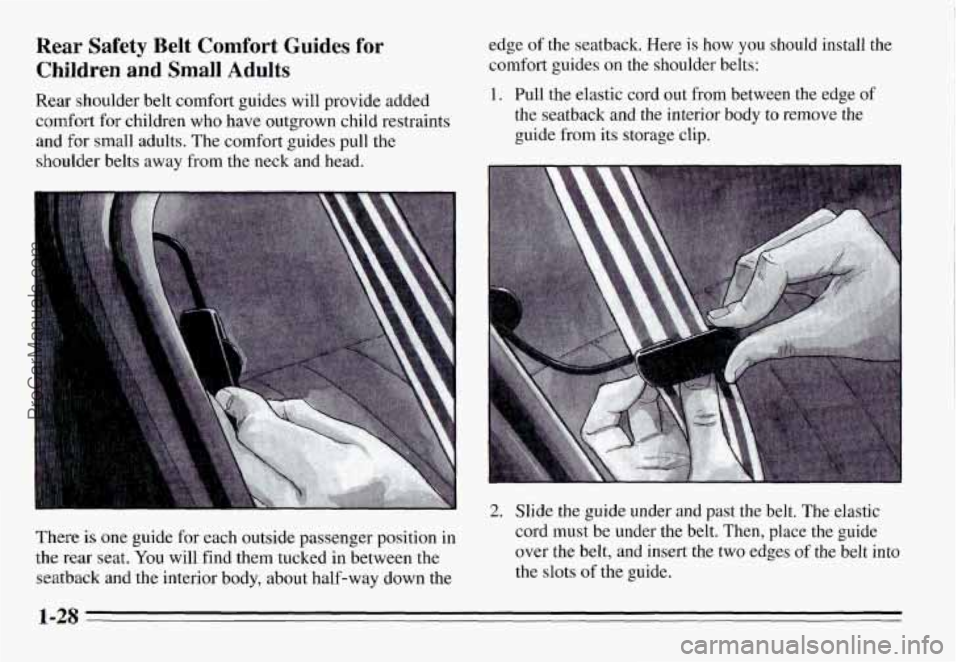
Rear Safety Belt Comfort Guides for
Children and Small Adults
Rear shoulder belt comfort guides will provide added
comfort for children who have outgrown child restraints
and
for small adults. The comfort guides pull the
shoulder belts away from the neck and head.
There is one guide for each outside passenger position in
the
rear seat. You will find them tucked in between the
seatback and the interior body, about half-way down the
edge of the seatback. Here is how you should install the
comfort guides on the shoulder belts:
1. Pull the elastic cord out from between the edge of
the seatback
and the interior body to remove the
guide from its storage'clip.
2. Slide the guide under and past the belt. The elastic
cord must be under the belt. Then, place the guide
over the belt, and insert
the two edges of the belt into
the slots of the guide.
1-28
ProCarManuals.com
Page 36 of 354
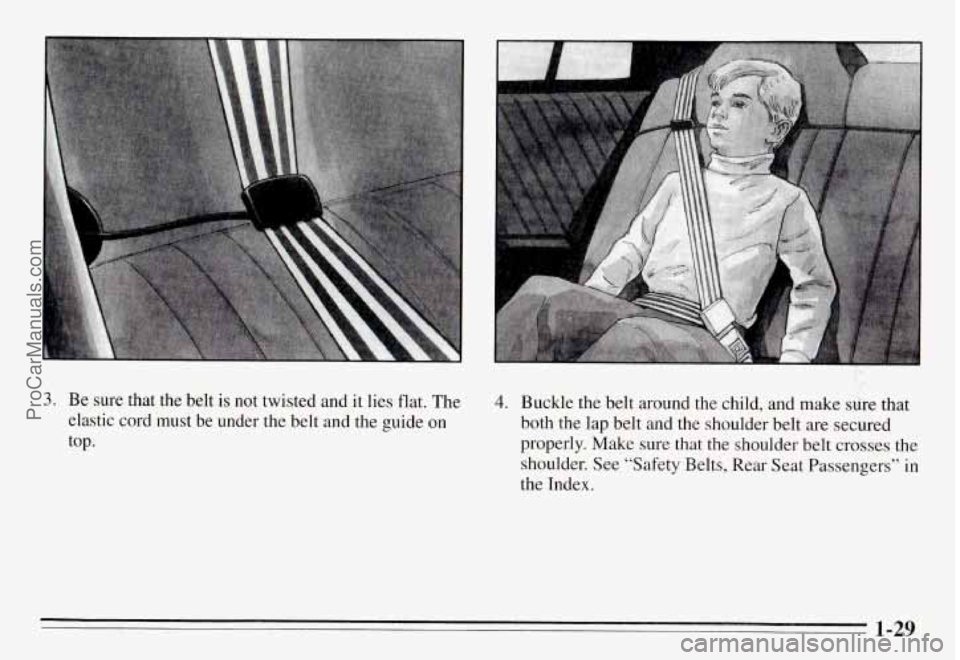
3. Be sure that the belt is not twisted and it lies flat. The
elastic cord must be under
the belt and the guide on
top.
4. Buckle the belt around the child, and make sure that
both the lap belt and the shoulder belt are secured
properly. Make sure that the shoulder belt crosses the
shoulder. See “Safety Belts, Rear Seat Passengers” in
the Index.
1-29
ProCarManuals.com
Page 37 of 354
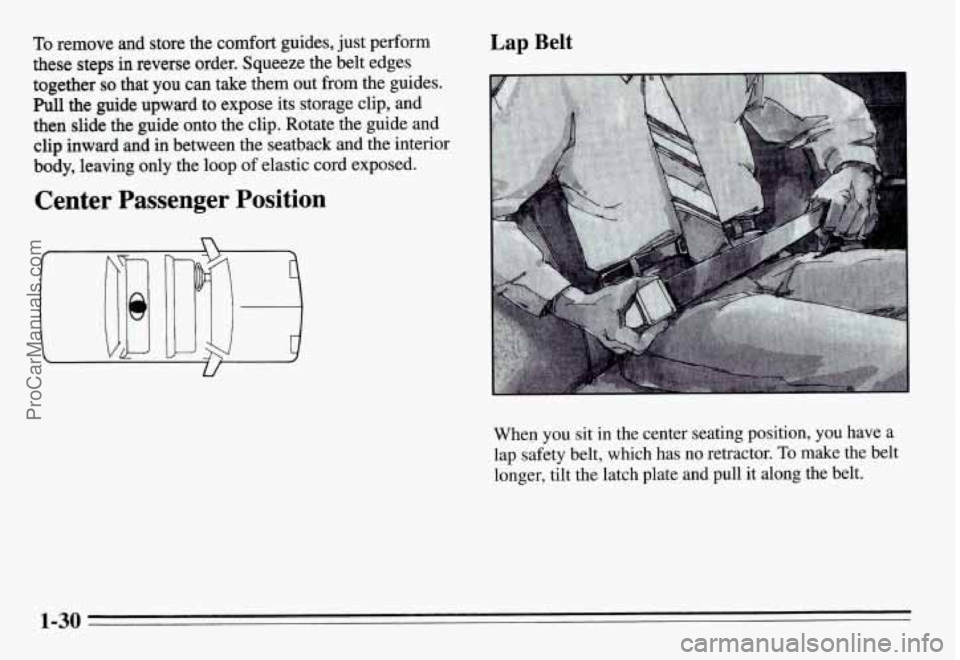
To remove and store the comfort guides, just perform
these steps
in reverse order. Squeeze the belt edges
together
so that you can take them out from the guides.
Pull the guide upward to expose its storage clip, and
then slide the guide onto the clip. Rotate the guide and
clip inward and in between the seatback and the interior
body, leaving only the loop
of elastic cord exposed.
Center Passenger Position
Lap Belt
U
When you sit in the center seating position, you have a
lap safety belt, which has no retractor. To make the belt
longer, tilt the latch plate and pull it along the belt.
1-30
ProCarManuals.com
Page 38 of 354
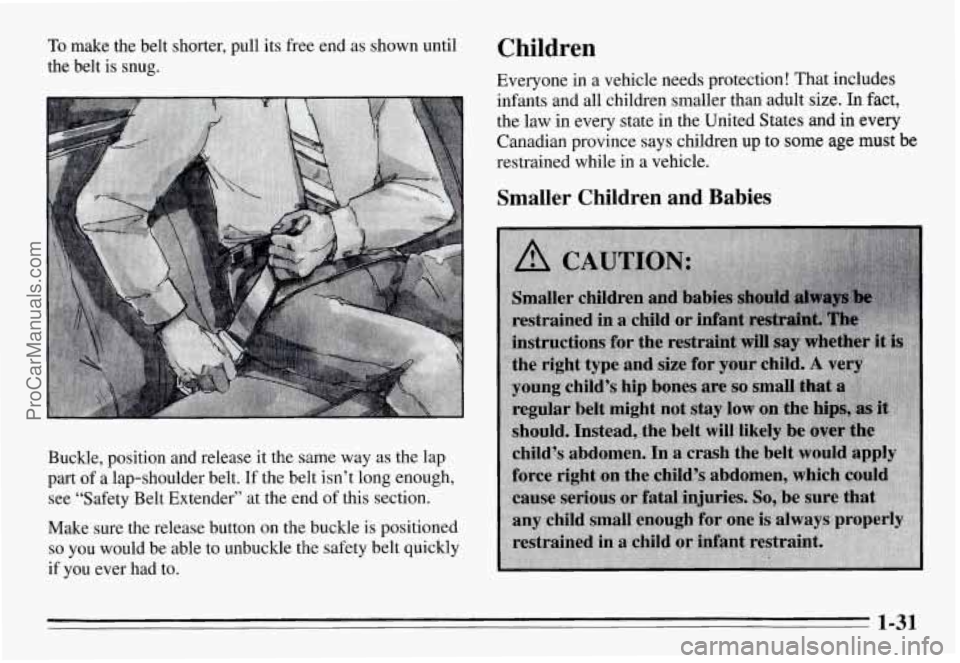
To make the belt shorter, pull its free end as shown until
the belt is snug.
Buckle, position and release it the same way as the lap
part
of a lap-shoulder belt. If the belt isn’t long enough,
see “Safety Belt Extender” at the end
of this section.
Make sure the release button on the buckle is positioned
so you would be able to unbuckle the safety belt quickly
if you ever had to.
Children
Everyone in a vehicle needs protection! That includes
infants and all children smaller than adult
size. In fact,
the law in every state in the United States and
in every
Canadian province says children up to some age must be
restrained while in a vehicle.
Smaller Children and Babies
1-31
ProCarManuals.com
Page 39 of 354
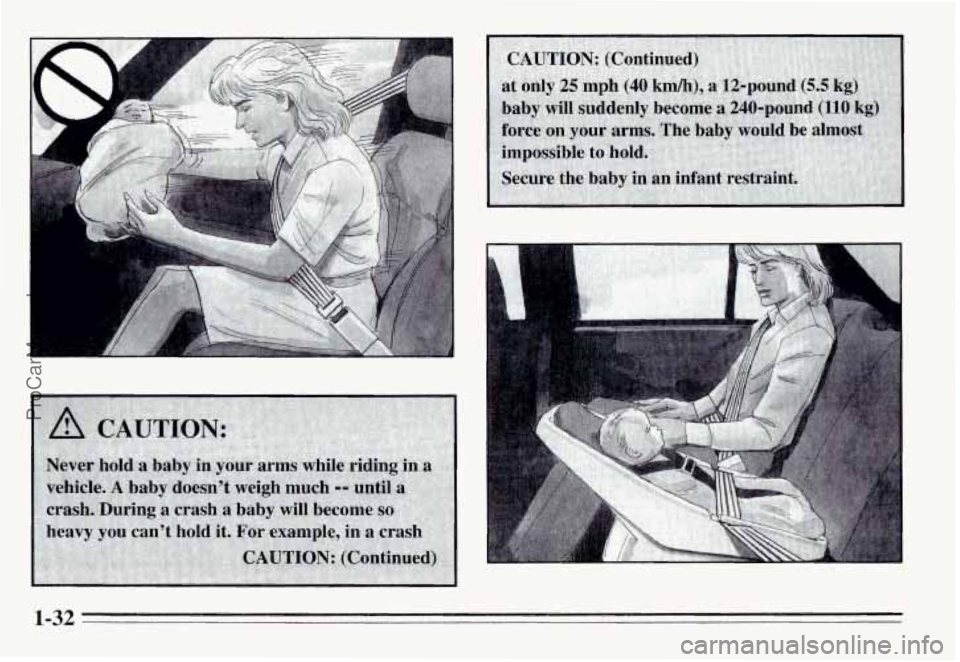
1-32
ProCarManuals.com
Page 40 of 354
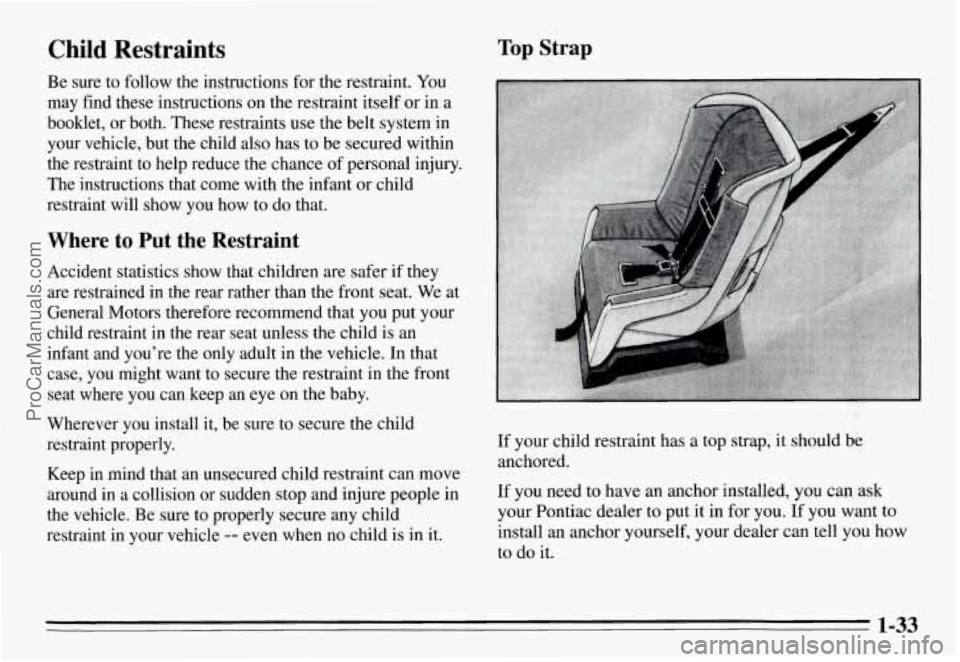
Child Restraints Top Strap
Be sure to follow the instructions for the restraint. You
may find these instructions on the restraint itself
or in a
booklet, or both. These restraints use the belt system in
your vehicle, but the child also has to be secured within
the restraint to help reduce the chance of personal injury.
The instructions that come with the infant or child
restraint will show you how to do that.
Where to Put the Restraint
Accident statistics show that children are safer if they
are restrained in the rear rather than the front seat. We at
General Motors therefore recommend that you put your
child restraint
in the rear seat unless the child is an
infant and you’re the only adult in the vehicle. In that
case, you might want to secure the restraint in the front
seat where you can keep an eye on the baby.
Wherever you install it, be sure to secure the child
restraint properly.
Keep in mind that an unsecured child restraint can move
around in a collision or sudden stop and injure people in
the vehicle. Be sure to properly secure any child
restraint in your vehicle
-- even when no child is in it.
If your child restraint has a top strap, it should be
anchored.
If you need to have an anchor installed, you can ask
your Pontiac dealer to put it in for you. If you want to
install an anchor yourself, your dealer
can tell you how
to do it.
1-33
ProCarManuals.com